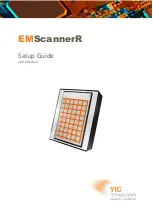
9
NUV
ANT
™
MCT Instructions for Use
ENGLISH
Indications for Use, Contraindications
and Precautions
Indications for Use
The NUVANT Mobile Cardiac Telemetry (MCT) System is intended to continu-
ously measure, record and periodically transmit physiological data. The System
is indicated for those patients who require monitoring for the detection of
non-lethal cardiac arrhythmias such as, but not limited to, supraventricular
tachycardias (e.g. atrial fibrillation, atrial flutter, paroxysmal SVTs), ventricular
ectopy, bradyarrhythmias and conduction disorders. The NUVANT MCT System
monitors, derives and displays: ECG, Heart Rate
Description of the System
The NUVANT MCT System consists primarily of the PiiX monitoring device,
the zLink data transmission device and a Patient Trigger Magnet (to enable
on-demand collection of ECGs). Once activated, the wearable PiiX sensor
continuously monitors the heart and automatically collects ECGs when rhythm
abnormalities are detected. Patients can also drive collection of ECGs when
they experience cardiac symptoms by using the Patient Trigger Magnet.
Data are automatically transmitted from the PiiX to the zLink, which then
automatically transmits the data to the Corventis Monitoring Center. Certified
cardiographic technicians at the Corventis Monitoring Center review received
data and document symptoms reported by patients. Clinical reports, prepared
by the Corventis Monitoring Center, are delivered and made available at
www.corventis.com to provide data to prescribing physicians for the diagnosis
and identification of various clinical conditions, events and/or trends.
Based on the indications, the NUVANT System may be used for:
1. Patients who require monitoring for suspected or known, non-life threat-
ening arrhythmias
2. Patients with symptoms such as chest pain, syncope, lightheadedness
or near syncope, vertigo, dizziness, fall, palpitations, transient ischemic
episodes, dyspnea (shortness of breath) that might be due to cardiac
arrhythmias.
3. Patients with cardiac arrhythmias associated with co-morbid conditions.
4. Obtaining correlation of rhythm with symptoms when symptoms have
unknown etiology.
5. Evaluating possible arrhythmias in a) patients recovering from cardiovas-
cular or thoracic surgery; b) survivors of myocardial infarction; c) patients
with diagnosed sleep disorder breathing.
6. Evaluating benefits after initiating or discontinuation of pharmacological
therapy (e.g., anti-arrhythmic, beta-blocker, anti-coagulation therapies).
7. Assessing the results of an ablation procedure for an arrhythmia.
8. Providing data to guide treatment decisions (e.g. pharmacological or
procedural/device-based treatments) and assessing treatment results in
patients with non-life threatening arrhythmias
Contraindications
1. Patients with known allergies or hypersensitivities to adhesives or hydrogel.
2. Patients with potentially life-threatening arrhythmias, or who require
inpatient / hospital monitoring.
Precautions
1. Minute ventilation sensing on implantable devices should be disabled for
the duration of PiiX usage
2. The Patient Trigger Magnet should not be used when PiiX are applied in
the vicinity of implanted devices with active magnet features.


































